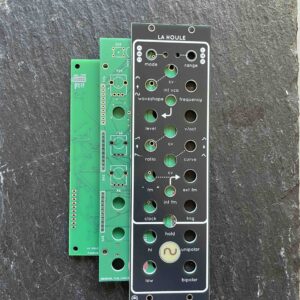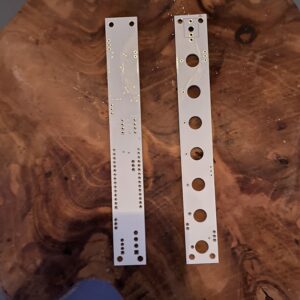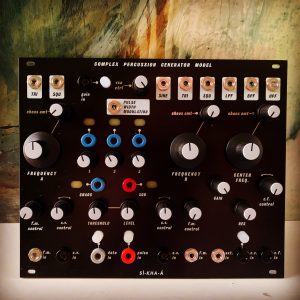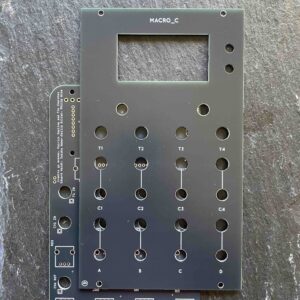Description
LA HOULE is about additive synthesis and many waves. It is the adaption of TIDES in Serge compatible format.
Two firmwares are available normal and parasites.
Parasites adds the following features to the module:
- Two-bumps: a silky 16-voices harmonic oscillator with two spectral bumps or notches, control over centroids and width, harmonics selection, wave quality, a sub-oscillator, a 1-bit output, and a special harmonics shuffling output for unusual, random timbres.
- Two-drunks: a complex duophonic random walk generator with selectable interpolation, driven by two altered clocks: one is jittery, the other simulates a biased coin toss. This mode is quite versatile and can be used as: an oscillator with PLL, a Bernoulli gate, a random trigger delay, a stepped, smooth or waveshaped random voltage generator, a random burst generator, a surprising filtered noise source… and probably more!
- A built-in quantizer with a choice of 7 scales.
Mode-switching interface
Tides Parasite can be used in three different modes, each being a completely different function. To switch between modes, press the two buttons simultaneously. The LED corresponding to the current mode blinks quickly for two seconds. Whithin these two seconds, the two press buttons, called Mode and Range in the manual, can be used to select a mode (Mode goes forward, Range goes back). After two seconds of inactivity, the selected mode is entered and the LEDs and buttons reclaim their normal function. The modes are:
- LED 1 (LED left side): function-generator mode (the original mode of the stock firmware)
- LED 2 (LED bottom side): Two-bumps mode: a harmonic oscillator.
- LED 3 (LED right side): Two-drunks mode: a random generator.
Quantizer
There is a built-in quantizer in Tides Parasite, which applies to all modes (including the original function-generator mode). To enable it, long-press on the Mode button (> 1s), then choose the active scale with the two buttons (Mode goes backwards, Range goes forward). The scales are indicated by a dim green LEDs using binary notation:
- ○○○: No quantization
- ●○○: Semitones
- ○●○: Major
- ●●○: Minor
- ○○●: Whole tones
- ●○●: Pentatonic minor
- ○●●: Poor pentatonic
- ●●●: Fifths
To exit scale selection, long-press Mode again (>1s); the chosen scale is then active. Note that the quantizer quantizes the Frequency knob and the V/Oct input. The FM input is not quantized.
Firmware update procedure only after performing the here under calibration!
Unplug all CV inputs/outputs from the module. Put the FM Switch to EXT FM and connect the output of your audio interface/sound card to the FM input. Power on your modular system with LA HOULE mode switch pressed. The 3 LEDs will blink, with a yellow color.
Make sure that no additional sound (such as email notification sounds, background music etc.) from your computer will be played during the procedure. Make sure that your speakers/monitors are not connected to your audio interface – the noises emitted during the procedure are aggressive and can harm your hearing. On non-studio audio equipment (for example the line output from a Desktop computer), you might have to turn up the gain to the maximum.
When you are all set, play the firmware update file into the module. The LEDs show a cyclic pattern and periodically flash green upon receiving a valid block of data. The unit reboots after the last packet has been received.
In case the signal level is inadequate or too high, the procedure will stop and all 3 LEDs will be lit in red. Try adjusting the output level, press the mode button and retry from the start of the update file.
Calibration procedure
This automatic procedure calibrates the V/Oct input (scale and offset), the FM input (offset), and the level input (offset).
- Set the FREQUENCY knob to its center position.
- Set switch to FM ext. Leave the other end of the cable unplugged (this prevents the normalling to \~1 semitone to be activated).
- Set the other switch to Level input. Leave the other end of the cable unplugged (this prevents the normalling to full scale to be activated).
- Connect a MIDI>CV interface or precision voltage source to the V/Oct input.
- Hold the Mode switch for one second. All LEDs are lit in yellow.
- Play a C2 note, or send a 1V voltage from your CV source.
- Press the mode switch (A). All LEDs are lit in green.
- Play a C4 note, or send a 3V voltage from your CV source.
- Press the mode switch.
The module is now calibrated for accurate V/Oct operation!
Bipolar output offset calibration
- Remove any patch cable from the trigger input.
- Set the mode to AD or AR (mode LED is red or green).
- Set the range to medium (range LED is off).
- Measure the voltage on the bipolar output. Adjust the trimmer on the back of the board so that this voltage reaches 0V.






























